Connect With Us
Blog
How Aging Can Affect Your Feet
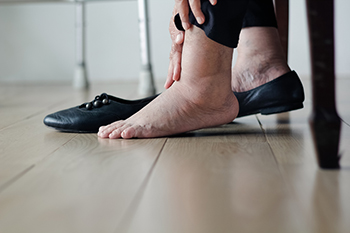
Aging gracefully is a journey that encompasses various changes throughout the body, and the feet are no exception. The intricate network of bones, muscles, and joints in the foot makes it particularly susceptible to the effects of aging. Certain conditions may arise, including plantar fasciitis, flat feet, and osteoarthritis. Plantar fasciitis involves inflammation of the ligament, called the plantar fascia, on the bottom of the foot. This condition often results from participating in high-impact exercises or wearing ill-fitting shoes. The telltale sign is sharp heel pain, especially pronounced in the morning. Flat feet, a consequence of aging and genetic predisposition, can lead to tired feet, painful arches, and swelling on the inner sides. This condition occurs when the supporting tendons and ligaments lose elasticity, a common side effect of aging, and causes the arches to weaken. Osteoarthritis, a prevalent concern for adults over 65, can affect the feet due to the intricate structure of bones and joints. While age increases the risk, repeated ankle sprains may also contribute to arthritis. If you are experiencing any of these foot problems, it is suggested that you schedule an appointment with a podiatrist.
Proper foot care is something many older adults forget to consider. If you have any concerns about your feet and ankles, contact one of our podiatrists from Family Foot and Ankle Care of Moriches. Our doctors can provide the care you need to keep you pain-free and on your feet.
The Elderly and Their Feet
As we age we start to notice many changes in our body, but the elder population may not notice them right away. Medical conditions may prevent the elderly to take notice of their foot health right away. Poor vision is a lead contributor to not taking action for the elderly.
Common Conditions
- Neuropathy – can reduce feeling in the feet and can hide many life-threatening medical conditions.
- Reduced flexibility – prevents the ability of proper toenail trimming, and foot cleaning. If left untreated, it may lead to further medical issues.
- Foot sores – amongst the older population can be serious before they are discovered. Some of the problematic conditions they may face are:
- Gouging toenails affecting nearby toe
- Shoes that don’t fit properly
- Pressure sores
- Loss of circulation in legs & feet
- Edema & swelling of feet and ankles
Susceptible Infections
Diabetes and poor circulation can cause general loss of sensitivity over the years, turning a simple cut into a serious issue.
If you have any questions please feel free to contact our offices located in Moriches and Shirley, NY . We offer the newest diagnostic and treatment technologies for all your foot and ankle needs.
Heel Pain Can Be Treated!
Ingrown Toenails and Their Causes
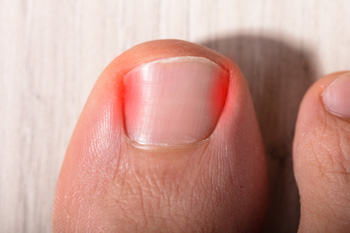
Ingrown toenails, a source of persistent discomfort, unfold as a condition where, instead of growing over the skin, the toenail curves and pierces the surrounding flesh. This occurrence often results in tenderness, redness, and swelling, creating an environment conducive to pain and potential infection. The causes of ingrown toenails are diverse, with improper nail trimming ranking among the primary culprits. Cutting the nails too short or rounding them excessively can encourage ingrowth. Wearing ill-fitting footwear, particularly shoes that crowd the toes, exerts pressure on the toenails and exacerbates the risk of ingrowth. Trauma or injury to the toe, such as stubbing, may also distort nail growth patterns. Genetic predispositions, where individuals inherit a tendency for irregular toenail growth, can contribute to this condition. If you have developed an ingrown toenail, it is strongly suggested that you consult a podiatrist in a timely manner so the correct treatment can begin.
Ingrown toenails can become painful if they are not treated properly. For more information about ingrown toenails, contact one of our podiatrists of Family Foot and Ankle Care of Moriches. Our doctors can provide the care you need to keep you pain-free and on your feet.
Ingrown Toenails
Ingrown toenails occur when a toenail grows sideways into the bed of the nail, causing pain, swelling, and possibly infection.
Causes
- Bacterial infections
- Improper nail cutting such as cutting it too short or not straight across
- Trauma to the toe, such as stubbing, which causes the nail to grow back irregularly
- Ill-fitting shoes that bunch the toes too close together
- Genetic predisposition
Prevention
Because ingrown toenails are not something found outside of shoe-wearing cultures, going barefoot as often as possible will decrease the likeliness of developing ingrown toenails. Wearing proper fitting shoes and using proper cutting techniques will also help decrease your risk of developing ingrown toenails.
Treatment
Ingrown toenails are a very treatable foot condition. In minor cases, soaking the affected area in salt or antibacterial soaps will not only help with the ingrown nail itself, but also help prevent any infections from occurring. In more severe cases, surgery is an option. In either case, speaking to your podiatrist about this condition will help you get a better understanding of specific treatment options that are right for you.
If you have any questions please feel free to contact our offices located in Moriches and Shirley, NY . We offer the newest diagnostic and treatment technologies for all your foot and ankle needs.
Athlete’s Foot Causes and Symptoms
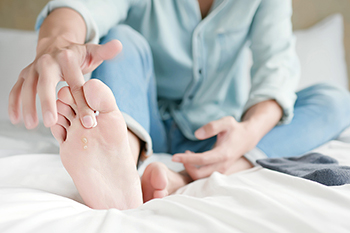
Athlete's foot is a fungal infection that can affect anyone, but certain factors can increase the risk of its development. Sweating profusely or wearing shoes and socks that promote excessive foot moisture create favorable conditions for the growth of the fungi responsible for athlete's foot. Those with weakened immune systems are particularly susceptible to infections, including fungal ones like athlete's foot. The transmission of athlete's foot from person to person is another factor to consider. The fungus responsible for the infection can be spread through direct contact with an infected person or by coming into contact with surfaces or items that carry the fungal spores. This makes environments such as communal showers, swimming pool areas, and gym locker rooms potential breeding grounds for the fungus. Common signs of athlete’s foot include an itchy, white, or scaly rash between the toes or on the feet, and flaky, infected skin that may peel off. For help in dealing with athlete’s foot, it is suggested that you schedule an appointment with a podiatrist for advanced treatment options.
Athlete’s foot is an inconvenient condition that can be easily reduced with the proper treatment. If you have any concerns about your feet and ankles, contact one of our podiatrists from Family Foot and Ankle Care of Moriches. Our doctors will treat your foot and ankle needs.
Athlete’s Foot: The Sole Story
Athlete's foot, also known as tinea pedis, can be an extremely contagious foot infection. It is commonly contracted in public changing areas and bathrooms, dormitory style living quarters, around locker rooms and public swimming pools, or anywhere your feet often come into contact with other people.
Solutions to Combat Athlete’s Foot
- Hydrate your feet by using lotion
- Exfoliate
- Buff off nails
- Use of anti-fungal products
- Examine your feet and visit your doctor if any suspicious blisters or cuts develop
Athlete’s foot can cause many irritating symptoms such as dry and flaking skin, itching, and redness. Some more severe symptoms can include bleeding and cracked skin, intense itching and burning, and even pain when walking. In the worst cases, Athlete’s foot can cause blistering as well. Speak to your podiatrist for a better understanding of the different causes of Athlete’s foot, as well as help in determining which treatment options are best for you.
If you have any questions please feel free to contact our offices located in Moriches and Shirley, NY . We offer the newest diagnostic and treatment technologies for all your foot and ankle needs.
Weighing the Pros and Cons of Bunion Surgery
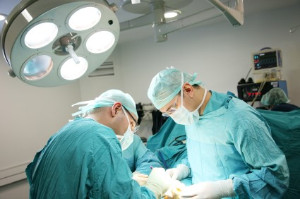
Bunion surgery, a consideration for those grappling with persistent discomfort and deformity, involves a meticulous assessment of its potential benefits and drawbacks. On the positive side, bunion surgery can provide relief from pain, improve the appearance of the foot, and enhance overall mobility. By correcting the misalignment of the big toe joint, surgery addresses the root cause of the bunion, preventing its progression. Increased joint function and reduced pressure on adjacent toes can contribute to improved overall foot health. However, the decision to undergo bunion surgery comes with its set of considerations. Potential drawbacks include the risks associated with any surgical procedure, such as infection, scarring, or adverse reactions to anesthesia. Postoperative recovery involves a period of limited mobility and potential discomfort. Additionally, the success of bunion surgery depends on various factors, including the severity of the bunion and the patient's commitment to postoperative care. If you have a bunion and are considering surgery, it is suggested that you schedule an appointment with a podiatrist who can help you to make an informed decision.
Foot surgery is sometimes necessary to treat a foot ailment. To learn more, contact one of our podiatrists of Family Foot and Ankle Care of Moriches. Our doctors will assist you with all of your foot and ankle needs.
When Is Surgery Necessary?
Foot and ankle surgery is generally reserved for cases in which less invasive, conservative procedures have failed to alleviate the problem. Some of the cases in which surgery may be necessary include:
- Removing foot deformities like bunions and bone spurs
- Severe arthritis that has caused bone issues
- Cosmetic reconstruction
What Types of Surgery Are There?
The type of surgery you receive will depend on the nature of the problem you have. Some of the possible surgeries include:
- Bunionectomy for painful bunions
- Surgical fusion for realignment of bones
- Neuropathy decompression surgery to treat nerve damage
Benefits of Surgery
Although surgery is usually a last resort, it can provide more complete pain relief compared to non-surgical methods and may allow you to finally resume full activity.
Surgical techniques have also become increasingly sophisticated. Techniques like endoscopic surgery allow for smaller incisions and faster recovery times.
If you have any questions please feel free to contact our offices located in Moriches and Shirley, NY . We offer the newest diagnostic and treatment technologies for all your foot and ankle needs.
Considerations for Choosing Running Shoes

Selecting the right pair of running shoes is paramount for a comfortable and injury-free experience. When embarking on this journey, consider the shoe's fit as a top priority. The shoe should snugly cradle the foot without causing tightness, allowing for a secure yet comfortable feel. Pay attention to the arch support, ensuring it complements the natural arch of your foot. Cushioning is vital for impact absorption, protecting joints and reducing the risk of injuries. Consider the type of running you engage in, including road running, trail running, or a mix of varied surfaces, and choose shoes tailored to the specific terrain. The heel counter, the back portion supporting the heel, should provide stability. Flexibility is also key. The shoes should bend where your foot naturally does. Lastly, examine the outsole for durability and traction. If you are seeking additional information about what type of running shoes to purchase, it is suggested that you confer with a podiatrist, who can provide you with the knowledge you are seeking.
You should always make sure your running shoes fit properly in order to avoid injury. For more information, contact one of our podiatrists from Family Foot and Ankle Care of Moriches. Our doctors can provide the care you need to keep you pain-free and on your feet.
Choosing the Right Running Shoe for Your Foot Type
Improper shoe sizing can cause a myriad of problems for your feet. Shoes that don’t fit you properly can lead to muscular imbalances in your body, which can result in foot, knee, and hip injuries.
Tips for Finding the Right Running Shoe
- Make sure you have a thumb’s width of wiggle room between the end of your longest toe and the front of the shoe.
- There should be little to no slipping at the heel
- Don’t assume your size in one shoe brand will be your size in another
- Do not lace up your shoes too tightly
- Walk around in the store with your new shoes before you buy them
If you have any questions please feel free to contact our our offices located in Moriches and Shirley, NY . We offer the newest diagnostic and treatment technologies for all your foot and ankle needs.
Reminder: When Was the Last Time...?
The Effects of Psoriatic Arthritis on the Feet and Ankles
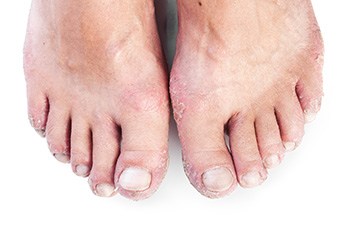
Psoriasis is a visible autoimmune disease characterized by red patches of skin with silvery scales. It results from an overactive immune system, attacking healthy tissue and causing excess skin cell production. However, this immune response can also trigger inflammation in joints. Approximately one-third of psoriasis patients develop psoriatic arthritis, or PsA, a chronic inflammatory joint disease. Often, psoriasis precedes PsA, but joint issues can emerge before skin symptoms, or may be so mild that patients do not connect them with psoriasis. Psoriatic arthritis can affect any joint, including the ankles and tendons around them. Symptoms include pain, tenderness, swelling, and warmth in the joints. Foot-related problems from PsA can include swelling of entire toes, heel pain from Achilles' tendon inflammation, and sole pain due to plantar fascia inflammation. Additionally, it can cause nail changes such as lifting, pitting, discoloration, or thickening. Managing PsA involves symptom control and joint protection. If you have psoriatic arthritis and it is impacting the comfort of your feet or ankles, it is suggested that you schedule an appointment with a podiatrist for a correct diagnosis and treatment options.
Arthritis can be a difficult condition to live with. If you are seeking treatment, contact one of our podiatrists from Family Foot and Ankle Care of Moriches. Our doctors can provide the care you need to keep you pain-free and on your feet.
Arthritic Foot Care
Arthritis is a joint disorder that involves the inflammation of different joints in your body, such as those in your feet. Arthritis is often caused by a degenerative joint disease and causes mild to severe pain in all affected areas. In addition to this, swelling and stiffness in the affected joints can also be a common symptom of arthritis.
In many cases, wearing ill-fitting shoes can worsen the effects and pain of arthritis. Wearing shoes that have a lower heel and extra room can help your feet feel more comfortable. In cases of rheumatoid arthritis, the arch in your foot may become problematic. Buying shoes with proper arch support that contour to your feet can help immensely.
Alleviating Arthritic Pain
- Exercises that stretch the foot can prevent further pain and injury and increase mobility
- Most of the pain can be alleviated with anti-inflammatory drugs, heat, and topical medications
- Massages can help temporarily alleviate pain.
It is best to see your doctor for the treatment that is right for your needs and symptoms. Conditions vary, and a podiatrist can help you determine the right method of care for your feet.
If you have any questions, please feel free to contact our offices located in Moriches and Shirley, NY . We offer the newest diagnostic tools and technology to treat your foot and ankle needs.
Treatment Options for a Torn Achilles Tendon
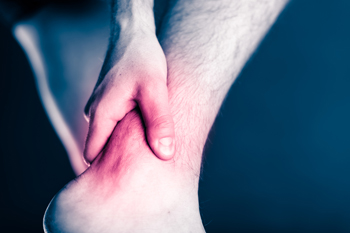
An Achilles tendon tear can be a debilitating injury, but with proper treatment, recovery is possible. The approach to treatment varies depending on the severity of the Achilles tendon tear. For partial tears, a common non-surgical option is immobilization by using a walking boot, leg brace, or splint for approximately six weeks. This restricts movement, allowing the tendon to heal correctly and prevent further damage. Using crutches may be necessary during this period to avoid putting weight on the injured ankle. Rest is an essential component of healing, along with keeping the injured leg elevated. In cases of an Achilles tendon rupture, or complete tear, surgery is likely to be necessary. Before the procedure, patients may wear a walking cast or boot to protect the injured area. During surgery, a podiatrist makes incisions down the back of the heel, reconnects the torn tendon, and stitches the wound closed. In post-surgery, patients wear a cast or splint to immobilize the tendon, with prescribed pain medication, and elevation to aid healing. If you have an Achilles tendon tear or rupture, it is suggested that you schedule an emergency appointment with a podiatrist for guidance on the proper treatment.
Achilles tendon injuries need immediate attention to avoid future complications. If you have any concerns, contact one of our podiatrists of Family Foot and Ankle Care of Moriches. Our doctors can provide the care you need to keep you pain-free and on your feet.
What Is the Achilles Tendon?
The Achilles tendon is a tendon that connects the lower leg muscles and calf to the heel of the foot. It is the strongest tendon in the human body and is essential for making movement possible. Because this tendon is such an integral part of the body, any injuries to it can create immense difficulties and should immediately be presented to a doctor.
What Are the Symptoms of an Achilles Tendon Injury?
There are various types of injuries that can affect the Achilles tendon. The two most common injuries are Achilles tendinitis and ruptures of the tendon.
Achilles Tendinitis Symptoms
- Inflammation
- Dull to severe pain
- Increased blood flow to the tendon
- Thickening of the tendon
Rupture Symptoms
- Extreme pain and swelling in the foot
- Total immobility
Treatment and Prevention
Achilles tendon injuries are diagnosed by a thorough physical evaluation, which can include an MRI. Treatment involves rest, physical therapy, and in some cases, surgery. However, various preventative measures can be taken to avoid these injuries, such as:
- Thorough stretching of the tendon before and after exercise
- Strengthening exercises like calf raises, squats, leg curls, leg extensions, leg raises, lunges, and leg presses
If you have any questions please feel free to contact our offices located in Moriches and Shirley, NY . We offer the newest diagnostic tools and technology to treat your foot and ankle needs.
Suggested Exercises for Flat Feet

Flat feet, or fallen arches, can lead to discomfort and negatively affect your posture, which can cause problems in other parts of the body. Strengthening the arches through targeted exercises for flat feet not only helps alleviate this discomfort but can also contribute to improved posture in the long run. The towel scrunch and stair heel raises are two of many exercises that can improve your arch strength. For the towel scrunch exercise, sit on a chair with a towel laid flat under your feet. Using only your toe muscles, scrunch the towel toward you until you can't pull it any further. Complete two sets with each foot and gradually increase sets as you feel more comfortable. To perform stair heel raises, stand on a step with only your toes and the balls of your feet on the step. Slowly raise your heel into the air, holding for a few seconds. Resist lowering your heel below the stair line for effectiveness. Begin with 10 raises as one set, aiming for three sets per day without pain. These exercises are designed for all fitness levels and can be done in the comfort of your home. Start at a beginner level and progress at your own pace. If you experience pain, it is a sign to stop. Also, it is beneficial to skip a day if your muscles are sore. For further guidance on methods to manage flat feet, it is suggested that you schedule an appointment with a podiatrist.
Flatfoot is a condition many people suffer from. If you have flat feet, contact one of our podiatrists from Family Foot and Ankle Care of Moriches. Our doctors will treat your foot and ankle needs.
What Are Flat Feet?
Flatfoot is a condition in which the arch of the foot is depressed and the sole of the foot is almost completely in contact with the ground. About 20-30% of the population generally has flat feet because their arches never formed during growth.
Conditions & Problems:
Having flat feet makes it difficult to run or walk because of the stress placed on the ankles.
Alignment – The general alignment of your legs can be disrupted, because the ankles move inward which can cause major discomfort.
Knees – If you have complications with your knees, flat feet can be a contributor to arthritis in that area.
Symptoms
- Pain around the heel or arch area
- Trouble standing on the tip toe
- Swelling around the inside of the ankle
- Flat look to one or both feet
- Having your shoes feel uneven when worn
Treatment
If you are experiencing pain and stress on the foot you may weaken the posterior tibial tendon, which runs around the inside of the ankle.
If you have any questions please feel free to contact our offices located in Moriches and Shirley, NY . We offer the newest diagnostic and treatment technologies for all your foot and ankle needs.
More...
A Guide to Choosing the Right Shoes for Work Environments
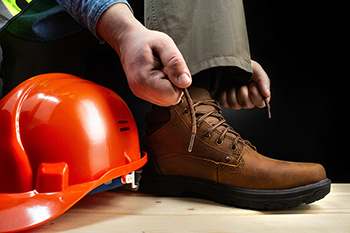
In the diverse landscape of workplaces, the importance of choosing the right shoes transcends mere fashion, it is a vital aspect of ensuring safety and protection. Different work environments demand varying levels of resilience from your footwear. Construction sites, for instance, call for sturdy, steel-toed boots to shield against potential impacts, while slip-resistant shoes are essential in restaurant kitchens to prevent accidents on slippery surfaces. For office settings, where comfort is often paramount, choosing supportive yet stylish shoes can enhance overall well-being. Understanding the specific hazards and demands of the work environment is key to selecting the appropriate footwear. Consider factors like arch support, toe protection, and sole grip to match the nature of the job. By investing in the right pair of shoes, individuals not only prioritize their safety but also pave the way for a more comfortable and productive work experience. If you would like more information about specific shoes to purchase for your work environment, it is suggested that you consult a podiatrist.
While working on the feet, it is important to take the proper care of them. For more information about working on your feet, contact one of our podiatrists from Family Foot and Ankle Care of Moriches. Our doctors will treat your foot and ankle needs.
Working on Your Feet
Standing on your feet for long periods of time can cause stress and pain in your feet. Your whole body may experience change in terms of posture, back pain, bunions, callouses and or plantar warts. There are ways to avoid these conditions with proper foot care, smart choices and correct posture.
Positive Changes
Negative heeled shoe – Choosing this shoe type places the heel slightly lower than the ball of the foot. These are great for overall foot health. Find shoes that fit you correctly.
Go barefoot – Our feet were not designed to be enclosed for all hours of the day. Try to periodically expose your feet to air.
Eliminate Pain
Foot Exercises – Performing simple exercises, incorporating yoga and doing stretches are beneficial. This will allow increased blood flow to the area and muscles of the foot.
Achilles tendon – Stretching the foot out flat on the floor will relax the calf muscles and tendon. These exercises can be performed almost anywhere. Make sure you add these exercises to your daily regimen.
With a little bit of this information and knowing more about foot health, you will notice changes. Foot stretches and proper footwear will help with pain and prevent further issues.
If you have any questions please feel free to contact our offices located in Moriches and Shirley, NY . We offer the newest diagnostic and treatment technologies for all your foot and ankle needs.
Plantar Warts Can Be Treated!
How Gout Affects Older Women

Gout, which is typically associated with men, can also affect women. Characterized by sudden, intense joint pain, swelling, and stiffness, this inflammatory condition primarily targets the feet and ankles in women. Symptoms of gout include redness, warmth, and limited mobility. Several factors contribute to gout in older women, including obesity, high blood pressure, and menopause, which heightens the risk. Menopausal hormonal changes disrupt uric acid balance, rendering women more susceptible to gout flares. Medication such as diuretics, commonly prescribed for high blood pressure, also may elevate uric acid levels, further affecting women. Postmenopausal women face an increased risk due to hormonal shifts. As estrogen declines during menopause, the risk of gout rises. Recognizing this connection is important for monitoring signs of gout in older women. Effective gout management in women includes implementing dietary modifications to reduce purine rich foods, in addition to weight maintenance and proper hydration. A podiatrist may prescribe certain medications that can help control uric acid levels. Gout's impact on women, particularly those who are postmenopausal, calls for some level of proactive measures. For more information about how to manage gout, it is suggested that you make an appointment with a podiatrist.
Gout is a painful condition that can be treated. If you are seeking treatment, contact one of our podiatrists from Family Foot and Ankle Care of Moriches. Our doctors will treat your foot and ankle needs.
What Is Gout?
Gout is a form of arthritis that is characterized by sudden, severe attacks of pain, redness, and tenderness in the joints. The condition usually affects the joint at the base of the big toe. A gout attack can occur at any random time, such as the middle of the night while you are asleep.
Symptoms
- Intense Joint Pain - Usually around the large joint of your big toe, and it most severe within the first four to twelve hours
- Lingering Discomfort - Joint discomfort may last from a few days to a few weeks
- Inflammation and Redness -Affected joints may become swollen, tender, warm and red
- Limited Range of Motion - May experience a decrease in joint mobility
Risk Factors
- Genetics - If family members have gout, you’re more likely to have it
- Medications - Diuretic medications can raise uric acid levels
- Gender/Age - Gout is more common in men until the age of 60. It is believed that estrogen protects women until that point
- Diet - Eating red meat and shellfish increases your risk
- Alcohol - Having more than two alcoholic drinks per day increases your risk
- Obesity - Obese people are at a higher risk for gout
Prior to visiting your podiatrist to receive treatment for gout, there are a few things you should do beforehand. If you have gout you should write down your symptoms--including when they started and how often you experience them, important medical information you may have, and any questions you may have. Writing down these three things will help your podiatrist in assessing your specific situation so that he or she may provide the best route of treatment for you.
If you have any questions, please feel free to contact our offices located in Moriches and Shirley, NY . We offer the newest diagnostic and treatment technologies for all your foot care needs.
Warning Signs From Your Feet

The condition of your feet can offer valuable insights into your overall health. For instance, if your feet are persistently cold, it may signal hypothyroidism, a condition that slows your metabolism. Yellow toenails may be a sign of lymphedema or respiratory issues. Persistent yellowing warrants a visit to a podiatrist for a diagnosis and treatment options. Painful foot cramps can result from dehydration or nutrient deficiencies. It is a good idea to stay hydrated, maintain a balanced diet, and consider drinking low-calorie sports drinks with electrolytes to prevent and relieve foot cramps. An enlarged, painful big toe may indicate gout. This is a form of arthritis that often affects the big toe. It results from an overabundance of purines in the system and can cause flare ups of extreme pain, swelling, and redness in the big toe. Reducing the risk of gout involves moderating alcohol intake and avoiding red meat and seafood consumption. If you are experiencing unusual types of foot problems, or suspect you may have gout, it is suggested that you make an appointment with a podiatrist for a full diagnosis and treatment options.
Everyday foot care is very important to prevent infection and other foot ailments. If you need your feet checked, contact one of our podiatrists from Family Foot and Ankle Care of Moriches. Our doctors can provide the care you need to keep you pain-free and on your feet.
Everyday Foot Care
Often, people take care of their bodies, face and hair more so than they do for their feet. But the feet are a very important aspect of our bodies, and one that we should pay more attention to. Without our feet, we would not be able to perform most daily tasks.
It is best to check your feet regularly to make sure there are no new bruises or cuts that you may not have noticed before. For dry feet, moisturizer can easily be a remedy and can be applied as often as necessary to the affected areas. Wearing shoes that fit well can also help you maintain good foot health, as well as making it easier to walk and do daily activities without the stress or pain of ill-fitting shoes, high heels, or even flip flops. Wearing clean socks with closed shoes is important to ensure that sweat and bacteria do not accumulate within the shoe. Clean socks help to prevent Athlete’s foot, fungi problems, bad odors, and can absorb sweat.
If you have any questions please feel free to contact our offices located in Moriches and Shirley, NY . We offer the newest diagnostic and treatment technologies for all your foot and ankle needs.
Blog Archives
- April 2024
- March 2024
- February 2024
- January 2024
- December 2023
- November 2023
- October 2023
- September 2023
- August 2023
- July 2023
- June 2023
- May 2023
- April 2023
- March 2023
- February 2023
- January 2023
- December 2022
- November 2022
- October 2022
- September 2022
- August 2022
- July 2022
- June 2022
- May 2022
- April 2022
- March 2022
- February 2022
- January 2022
- December 2021
- November 2021
- October 2021
- September 2021
- August 2021
- July 2021
- June 2021
- May 2021
- April 2021
- March 2021
- February 2021
- January 2021
- December 2020
- November 2020
- October 2020
- September 2020
- August 2020
- July 2020
- June 2020
- May 2020
- April 2020
- March 2020
- February 2020
- January 2020
- December 2019
- November 2019
- October 2019
- September 2019
- August 2019
- July 2019
- June 2019
- May 2019
- April 2019
- March 2019
- February 2019
- January 2019
- December 2018
- November 2018
- October 2018
- September 2018
- August 2018
- July 2018
- June 2018
- May 2018
- April 2018
- March 2018
- February 2018
- January 2018
- December 2017
- November 2017
- October 2017
- September 2017
- August 2017
- July 2017
- June 2017
- May 2017
- April 2017
- March 2017
- February 2017
- January 2017
- December 2016
- November 2016
- October 2016
- September 2016
- August 2016
- July 2016
- June 2016
- October 2015
- September 2015
- August 2015
- July 2015
- June 2015
- May 2015
- April 2015






